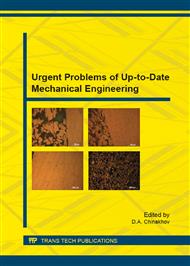[1]
D.A. Konek, K. W. Wojciechowski and other, Materials with negative Poisson's ratio. (Review), J. Mechanics of composite materials and constructions. 10 (2004) 35 – 69.
Google Scholar
[2]
S. P. Tokmakova, Stereographic projections of Poisson¢s ratio in auxetic crystals, J. Phys. Stat. Sol. (b). 242 (2005) 721 – 729.
DOI: 10.1002/pssb.200460389
Google Scholar
[3]
A. W. Lipsett, A. I. Beltzer, Reexamination of dynamic problems of elasticity for negative Poisson¢s ratio, J. Acoust. Soc. Am. 84 (1988) 2179 – 2186.
DOI: 10.1121/1.397064
Google Scholar
[4]
V. N. Belomestnykh, E. G. Soboleva, Acoustic analogs of elasticity theory ratios for determining anisotropic Poisson ratios of cubic monocrystals, 7th International Forum on Strategic Technology (IFOST - 2012), 1 (2012) 499-502.
DOI: 10.1109/ifost.2012.6357527
Google Scholar
[5]
E. Тesleva, T. Belkova, Acoustic and elastic properties of Cu3Au alloy between 4. 2.. 300 К, J. Applied Mechanics and Materials. 682 (2014) 519-524.
DOI: 10.4028/www.scientific.net/amm.682.519
Google Scholar
[6]
Tu Hailing, G. A. Saunders and other, Poisson¢s ratio limits and effects of hydrostatic pressure of the elastic behavior of Sm1-xYxS alloys in the intermediate valence state, J. Phys. C: Solid State Phys. 17 (1984) 4559 – 4573.
DOI: 10.1088/0022-3719/17/26/007
Google Scholar
[7]
V. N. Belomestnykh, E. P. Tesleva, Elastic properties of solid solutions with intermediate valence Sm1-xLaxS, 7th International Forum on Strategic Technology (IFOST - 2012). 2 (2012) 381-384.
DOI: 10.1109/ifost.2012.6357768
Google Scholar
[8]
I. N. Frantsevich, F. F. Voronov, S. A. Bakuta, Elastic constants and elastic moduli of metals and non-metals, Kiev, (1982).
Google Scholar
[9]
G. L. Peresada, On the calculation of elastic moduli of polycrystalline systems from single crystal data, J. Phys. Status Solidi. 4 (1971) 23 – 27.
DOI: 10.1002/pssa.2210040136
Google Scholar
[10]
K. S. Alexandrov, To the problem of calculating elastic constants of quasiisotropic polycrystalline materials, J. Reports of Academy of Sciences USSR. 176 (1967) 295 – 297.
Google Scholar
[11]
R. Truell, Ch. Elbaum, B. Chik, Ultrasonic methods in physics of solids, Moscow, (1972).
Google Scholar
[12]
V. N. Belomestnykh, E. P. Tesleva, E.G. Soboleva, Maximum Grüneisen constants for polymorph transformations in crystals, J. Technical Physics Letters. 34 (2008) 867–869.
DOI: 10.1134/s1063785008100179
Google Scholar


